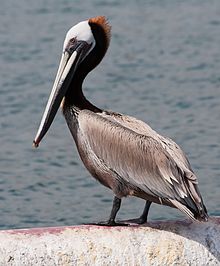Pelecaniformes
| Pelecaniformes Temporal range: Late Cretaceous–recent, 66–0 Ma |
|
|---|---|
 |
|
| Brown pelican (Pelecanus occidentalis) | |
| Scientific classification | |
| Kingdom: | Animalia |
| Phylum: | Chordata |
| Class: | Aves |
| Clade: | Aequornithes |
| Order: |
Pelecaniformes Sharpe, 1891 |
| Families | |
|
|
 |
|
| Global distribution of the Pelecaniformes | |
The Pelecaniformes is an order of medium-sized and large waterbirds found worldwide. As traditionally—but erroneously—defined, they encompass all birds that have feet with all four toes webbed. Hence, they were formerly also known by such names as totipalmates or steganopodes. Most have a bare throat patch (gular patch), and the nostrils have evolved into dysfunctional slits, forcing them to breathe through their mouths. They feed on fish, squid or similar marine life. Nesting is colonial, but individual birds are monogamous. The young are altricial, hatching from the egg helpless and naked in most. They lack a brood patch.
Fregatidae (frigatebirds), Sulidae (gannets and boobies), Phalacrocoracidae (cormorants and shags), Anhingidae (darters) and the Phaethontidae (tropicbirds) were traditionally placed in the Pelecaniformes, but molecular and morphological studies indicate they are not such close relatives. They have been placed in their own orders, Phaethontiformes and Suliformes, respectively.
Classically, bird relationships were based solely on morphological characteristics. The Pelecaniformes were traditionally—but erroneously—defined as birds that have feet with all four toes webbed (totipalmate), as opposed to all other birds with webbed feet where only three of four were webbed. Hence, they were formerly also known by such names as totipalmates or steganopodes. The group included frigatebirds, gannets, cormorants, anhingas and tropicbirds.
Sibley and Ahlquist's landmark DNA-DNA hybridisation studies (see Sibley-Ahlquist taxonomy) led to them placing the families traditionally contained within the Pelecaniformes together with the grebes, cormorants, ibises and spoonbills, New World vultures, storks, penguins, albatrosses, petrels, and loons together as a sub-group within a greatly expanded order Ciconiiformes, a radical move which by now has been all but rejected: their "Ciconiiformes" merely assembled all early advanced land- and seabirds for which their research technique delivered insufficient phylogenetic resolution.
...
Wikipedia
